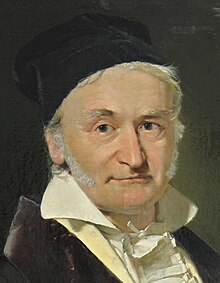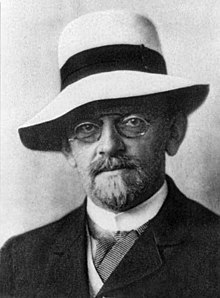Mathematical rigor
Under mathematical rigor (in a slightly different context often mathematical precision ) is a clear logical approach within the mathematics understood and others on her based sciences. It includes, on the one hand, the axiomatic approach based on strict definitions and, on the other hand, compelling evidence . The method of systematic deduction is also sought. As a consequence, mathematical theorems are in principle final and universal truths, so that mathematics can be regarded as the exact science. Mathematical rigor is not an end in itself, but a necessary means to enable lasting progress in mathematics. It is also a good school of thought in the Greek sense . In the aftermath, the mathematical rigor also results in a simplification of mathematical considerations.
history

Already in the Greek mathematics can be found especially in Euclid in his elements (the end of the 4th century. V. Chr.) First attempts by mathematical rigor Axiomatization and systematic mathematical deduction. In ancient times, however, a less strict treatment of mathematics than Euclidean was often preferred. It was also clear that the principle of mathematical rigor cannot be applied to all sciences . Thus writes Aristotle "Mathematical rigor is not to call in all things, but probably in the non-material." After a long period of stagnation began in the 17th century a revival of the mathematical sciences with analytic geometry and calculus . However, the Greek ideal of axiomatics and systematic deduction was a hindrance to the productive mathematicians of the time. The results played a bigger role than the way there. A strong intuitive feeling and an almost blind conviction of the power of the newly invented methods initially justified this approach. The age of the beginning industrialization supported this form even further. With this self-assurance, Sylvestre Lacroix said in 1810 : "We no longer need such subtleties, with which the Greeks tormented themselves."
Only at the beginning of the 19th century was the rapidly increasing belief in progress replaced by a newly awakening self-criticism. The need for certainty of the results and clarity arose. This process was supported by a strong popularization of the sciences after the French Revolution .
The Disquisitiones Arithmeticae by Carl Friedrich Gauß are considered to be one of the first exemplary works of mathematical rigor. It is written entirely in the style of theorem - proof - corollary , contains no motivation for the lines of evidence taken and carefully hides the way in which Gauss came to his discoveries. The last aspect, however, is based in part on the requirement of mathematical rigor and not on a particular quirk of Gauss. It is related to the demand for absolute " freedom from redundancy " discussed below .
Thanks to the work of Augustin Louis Cauchy and Karl Weierstrass , the infinitesimal calculus in particular was placed on a secure and strict basis. The 19th century was thus marked by a successful reflection on the classical ideal of precision and the rigor of argumentation, with the example of Greek science being exceeded. Already before Cauchy, Bernard Bolzano made an important contribution to the strict treatment of analysis in 1817 with the work Purely analytical proof of the theorem that between two values that grant an opposite result there is at least one real root of the equation .
Quotes
One of the main advocates of mathematical rigor combined with enormous versatility was David Hilbert . He formulated at the International Congress of Mathematicians in Paris in 1900:
“We shall briefly discuss what justifiable general demands are to be made on the solution of a mathematical problem: I mean above all that the correctness of the answer can be demonstrated by a finite number of inferences on the basis of a finite number of Prerequisites which lie in the problem and which must be precisely formulated each time. This requirement of logical deduction by means of a finite number of inferences is nothing other than the requirement of rigor in the argumentation. Indeed, the requirement of rigor, which, as is well known, has become of proverbial importance in mathematics, corresponds to a general philosophical need of our understanding, and on the other hand, it is only through its fulfillment that the conceptual content and the fruitfulness of the problem come into full effect. A new problem, especially if it comes from the external world, is like a young rice, which only thrives and bears fruit if it is grafted carefully and according to the strict rules of the gardener onto the old trunk, the safe possession of our mathematical knowledge becomes.
It is also a mistake to believe that rigor in reasoning is the enemy of simplicity. On the contrary, in numerous examples we find confirmation that the strict method is at the same time the simpler and easier to grasp. Striving for severity forces us to find simpler modes of inference; it also often paves the way for us to methods that are more capable of development than the old, less rigorous methods. "
Alexander Danilovich Alexandrov said:
“Morally, mathematics teaches us to be strict about what is asserted as truth, what is argued, or what is given as evidence. Mathematics demands clarity of terms and assertions and does not tolerate fog or unprovable explanations. "
Freedom from redundancy
The personal characteristics of Carl Friedrich Gauß indicated above were quasi " internalized " by mathematicians , through the implicitly or explicitly required principle of freedom from redundancy : All superfluous statements should be eliminated and understanding of what has been said is left to the reader (factual correctness and importance provided). In a typical mathematical work, in addition to sentence statements, prerequisites and the implementation of proof steps, justifying statements of the following kind are desired at best: "This result is important because ...", so that the individual statements are at least brought into the correct context. This principle of “freedom from redundancy” is useful or necessary for the realization of mathematical rigor and prohibits personally colored additions as “superfluous and u. U. even harmful to the matter ”, but at the same time it is one of the greatest obstacles to the comprehensibility of many mathematical statements, or in general a main reason for the often lamented incomprehensibility of the“ mathematical style ”with its lemmas , theorems and corollaries including the lack of transparency of many of them Evidence .
The Bourbaists
The “mathematical style” was particularly pronounced and increasingly abstract in the works published under the pseudonym Nicolas Bourbaki , extensive handbooks, a group of outstanding French mathematicians who, from 1934 onwards, strived for an overall presentation of mathematics. After decades of dominant influence by this collective of authors, however, the trend towards increasing severity and abstraction is now apparently on the decline.
See also
literature
- Günther Eisenreich , Ralf Sube: Langenscheidt's specialist dictionary of mathematics: English, German, French, Russian . 4th edition. Langenscheidt, Berlin 1996, ISBN 3-86117-074-4 . On p. 499 (M 171) [GN general] it is stated : mathematical rigor , mathematische Strenge, riguer mathématique ; P. 726 (R 1305) [GN general] rigorous proof , strict proof, demonstration rigoureuse
- Richard Courant , Herbert Robbins: What is Mathematics? Springer-Verlag, Berlin / Heidelberg 2000, ISBN 3-540-63777-X .
- Hans Niels Jahnke (Ed.): History of Analysis . Spectrum Academic Publishing House, Berlin 1999.
- Oskar Becker : Size and limits of the mathematical way of thinking . Verlag Karl Alber, Freiburg / Munich 1959, Critical Justification of Analysis, p. 108–111 (Studium Universale).
- Harro Heuser : Textbook of Analysis . 11th edition. Part 2. Teubner, Stuttgart 2000, ISBN 3-519-42234-4 , chapter 29: A historical tour d'horizon , section: Die neue Strenge , p. 689-700 .
- Philip Davis , Reuben Hersh : Experience Mathematics. With an introduction by Hans Freudenthal . From the American by Jeannette Zehnder . 2nd Edition. Birkhäuser, Basel 1996.
- Tom Archibald: The Development of Mathematical Rigor in Analysis . In Timothy Gowers , June Barrow-Green , Imre Leader (Eds.): The Princeton Companion to Mathematics . Princeton University Press 2008, ISBN 978-0-691-11880-2 , pp. 117–129 ( restricted online version in Google Book Search - USA )
- Israel Kleiner : Rigor and Proof in Mathematics: A Historical Perspective . (PDF; 410 kB) In: Mathematics Magazine , Vol. 64, No. 5 (Dec., 1991), pp. 291-314
- Haskell Brooks Curry : Some aspects of the problem of mathematical rigor . (PDF; 2.3 MB) In: Bulletin of the American Mathematical Society , 1941
- James Pierpont : Mathematical rigor, past and present . In: Bulletin of the American Mathematical Society , 1928
Web links
- Eric W. Weisstein : Rigorous . In: MathWorld (English).
Individual evidence
- ↑ Aristotle. Bibl. Didotiana, vol. 10, Aristotelis Opera II. De Gruyter, Berlin 1970, p. 488
- ↑ Heuser, p. 689
- ^ David Hilbert: Mathematical Problems . ( Memento of the original from January 19, 2012 in the Internet Archive ) Info: The archive link was inserted automatically and has not yet been checked. Please check the original and archive link according to the instructions and then remove this notice. Lecture, published as: Mathematical Problems. Lecture given at the International Congress of Mathematicians in Paris in 1900 , News from the Society of Sciences in Göttingen, Mathematical-Physical Class. No. 3, pp. 253-297
- ^ Heiner Stauff: Mathematical rigor .




